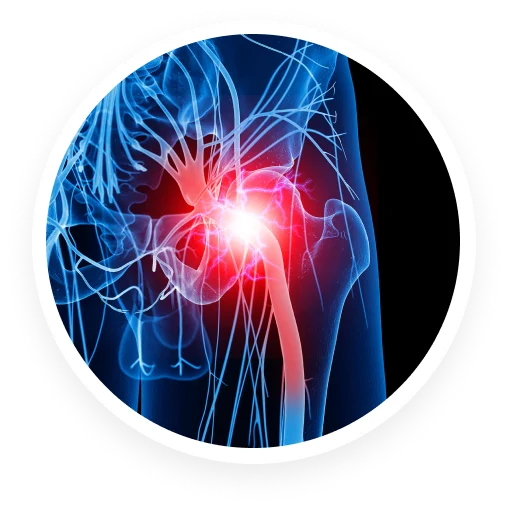
Sciatica
Sciatica is related to inflammation of the sciatic nerve.
Allen Finney
Review
Young ladies behind the counter were nice and professional. Dr. Khan was and is awesome. You felt he really cared which I have not felt in the 2 years I've been injured. Only reason I did not give it 5 stars was the hard time I had finding it.
Allen Finney
Review
Young ladies behind the counter were nice and professional. Dr. Khan was and is awesome. You felt he really cared which I have not felt in the 2 years I've been injured. Only reason I did not give it 5 stars was the hard time I had finding it.
charles griffin
Review
Have been doing a wonderful job with help with my nerve pain, listen to me, and my request no to be put on pain killers but to help find the problem, always return calls so glad is was referred to them.
Stacey Mejia
Review
Awesome staff Dr. Kahn is a really good Doctor he listens and is a helping man!! I appreciate all of your guys work you do for your patients!! You even call to give reminder the day before your appointment! Again that's so awesome!!
Forrest Hammer
Review
NOTHING BUT THE BEST. ABLE TO WALK. ABLE TO PERFORM TASKS THAT I COULDN'T FOR A LONG TIME, LIKE DAILY WALKING, BENDING OVER, CARRYING GROCERIES AND ENJOYING A MOVIE AT THE CINEMA. THANK YOU DR. ASIM KAHN.
Jeanne Neathery
Review
Dr RYklin is amazing. He treats each patient as if you’re his only one. I’ve been seeing him for 7yrs due to a neck injury. He definitely finds what pain management meets your individual needs. The practitioners are amazing as well!!!!
Marty Klopper
Review
Pain Dr office. Staff is friendly and professional. Lots of paper work to be filled out. Office was clean and neat. Masks on Staff at all times and required for patients to enter. Will be going back for follow-up appointments.
Kim LindL
Review
The staff is very pleasant and Dr. Khan is very good with a needle I've been getting epidurals and shots in my foot and lower back for about 4 years now, he is very good and I would never go to another place
Angel Bussert
Review
The doctor actually listens. I have been a patient for years and love the staff and doctors. I've been to all the locations the country club one is always super busy queen creek location is never packed so I go there.
Guy Romero Jr
Review
Every Staff personnel are very professional, courteous and patient respectful in caring for each medical problem. We live out in Laveen, but finding good patient care are hard to find, Truly Blessed Guy E Romero
John Crosby
Review
They do a great job in today's challenging health care system. Great Nurse Practitioners who work hard. Great support staff. Doctors are expert practitioners. Stable practice. I have over five years personal experience with them.
Stacey Mejia
Review
Awesome staff Dr. Kahn is a really good Doctor he listens and is a helping man!! I appreciate all of your guys work you do for your patients!! You even call to give reminder the day before your appointment! Again that's so awesome!!
Kim LindL
Review
The staff is very pleasant and Dr. Khan is very good with a needle I've been getting epidurals and shots in my foot and lower back for about 4 years now, he is very good and I would never go to another place
Guy Romero Jr
Review
Every Staff personnel are very professional, courteous and patient respectful in caring for each medical problem. We live out in Laveen, but finding good patient care are hard to find, Truly Blessed Guy E Romero
Angel Bussert
Review
The doctor actually listens. I have been a patient for years and love the staff and doctors. I've been to all the locations the country club one is always super busy queen creek location is never packed so I go there.
Forrest Hammer
Review
NOTHING BUT THE BEST. ABLE TO WALK. ABLE TO PERFORM TASKS THAT I COULDN'T FOR A LONG TIME, LIKE DAILY WALKING, BENDING OVER, CARRYING GROCERIES AND ENJOYING A MOVIE AT THE CINEMA. THANK YOU DR. ASIM KAHN.
Jeanne Neathery
Review
Dr RYklin is amazing. He treats each patient as if you’re his only one. I’ve been seeing him for 7yrs due to a neck injury. He definitely finds what pain management meets your individual needs. The practitioners are amazing as well!!!!
Marty Klopper
Review
Pain Dr office. Staff is friendly and professional. Lots of paper work to be filled out. Office was clean and neat. Masks on Staff at all times and required for patients to enter. Will be going back for follow-up appointments.
John Crosby
Review
They do a great job in today's challenging health care system. Great Nurse Practitioners who work hard. Great support staff. Doctors are expert practitioners. Stable practice. I have over five years personal experience with them.
Carol Gravatt Davidson
Review
Absolutely the best place I have been too...so many doctors and always just prescribed pain pills for over 10 years. There is hope, after starting injections I feel so much better. I know I'm in the right place.
Tim Tuzon
Review
Been with Kahn for over a year and wouldn't want to be anywhere else. He is not a pharmacy! He solves the issues instead of hiding them with tons of drugs. Have had multiple procedures to correct the problems.
Brooke Keifer
Review
I was nervous when I brought my mom into the office. They are clearly a very busy office, but the front staff was kind, and the doctor was very confident in a treatment plan. Overall my Mom was very pleased with her visit.
Kari Lynn Plo
Review
I love Dr Ryklin and his assistant Liza! They've always been super good to me and very sympathetic to all my needs! They've done everything they can to make me comfortable and to help me with my pain! I'd refer anyone to them!
Lacey Smithson
Review
This office keeps getting better every time I go. Staff is friendly, doctors are very well educated and good at what they do. And they have helped decrease my mom's back pain by 80%! Everyone with pain should go to this place!
Katty Miller
Review
Dr. Khan is truly carrying, understanding and the VERY BEST AT ADMINISTRATING SGB INJECTIONS!!! I look forward to driving from California to be seen by him. I just can't say enough. Thank you Dr. Khan.
Britt Montoya
Review
Great place. Dr Khan is an awesome Dr and goes above and beyond to help you. Meghan is a wonderful P.A. as well. It says so much to have a Dr that truly cares about your outcome of your procedures. This is a goodhearted Dr
Julie Kierzek (Julz)
Review
Love them all. Dr Ryklin is so helpful and understanding. He takes helping people seriously & I'm extremely grateful for everything he & the PA's & MA's have done for me. Dr Ryklin has gone above & beyond for me.

What is sciatica?
Sciatica refers to pain in the hips, legs, lower back, or glutes caused by pinching or inflammation of the sciatic nerve. This nerve starts in the lower back and continues through the hips and both legs. Often, sciatic pain can be resolved at home. However, some cases require medical attention.
What are the symptoms of sciatica?
Most symptoms of sciatica occur along the sciatic nerve. Some of the most common sciatica symptoms are shooting pain, tingling, numbness, burning, and muscle weakness.
It’s common for sciatica pain to feel sharp, shooting, or result in a burning sensation. Pain may occur in the glutes, hips, lower back, or down one of your legs. Sciatic leg pain usually only occurs in one leg at a time.
Numbness may occur due to sciatica as well, most often experienced in the feet or legs. Tingling and muscle weakness typically occur in the legs, toes, and feet, which may feel like a pins and needles sensation.
Sciatic pain may be aggravated if you sneeze, cough, or if you stand or sit for prolonged periods. Depending on the person, this medical condition may occur suddenly, or it may take time for it to appear.
What causes sciatica?
The most common cause of sciatica is a herniated or bulging disc. However, sciatica can also be caused by bone spurs, spinal stenosis, injuries, tumors, and piriformis syndrome.
Obesity, diabetes, age, and a sedentary lifestyle can all lead to sciatica as well. While these factors are not causing themselves, they can lead to herniated disks, bone spurs, and stress on the spine. All of these can lead to sciatica.
It’s essential to try to pinpoint any underlying causes. Getting to the root of the problem may help us form a treatment plan to reduce pain more effectively. It can also prevent sciatica from reoccurring.
How is sciatica treated?
Sciatica symptoms in the hips, glutes, legs, and back may all be relieved through anti-inflammatory medications. Common pain relievers used are ibuprofen, naproxen, acetaminophen, and aspirin. If necessary, your doctor may prescribe a prescription pain reliever. Depending on your symptoms, your doctor may prescribe muscle relaxers. This type of medication is used to relieve muscle spasms, which can cause considerable pain.
Physical therapy is also a common treatment used to combat sciatica. A physical therapist can work with you to strengthen weak areas most affected by sciatica, specifically your core. Soft tissues such as muscles, ligaments, and tendons may need special attention. A physical therapist can also give you at-home stretches and exercises to complete to help your recovery.
In some cases, your physician may administer steroid injections. These injections reduce inflammation around the sciatic nerve; however, they are spaced out and limited due to side effects. Your physician may also prescribe oral steroids to treat your pain.
Exercise may be encouraged, as well. While it is crucial to get enough rest, maintaining physical activity is also essential. You may need to modify how much physical activity you get each day. Swimming and walking are great options for low impact exercise. However, talk to our doctor before engaging in any activity.
Cold packs or heating pads may provide temporary pain relief. Consider limiting bed rest as well. Movement can be useful when treating sciatica. Some patients find relief through chiropractic manipulation and acupuncture as well.
Your physician may suggest surgery if nothing else works and severe symptoms are present. These symptoms may include urinary and bowel incontinence or extreme weakness. Surgery is usually reserved for severe cases of sciatica.
AZ Pain and Spine Institute
Sciatica Treatments
Here at Arizona Pain and Spine Institute, we improve our patients’ quality of life by alleviating and managing their pain. Some of our Sciatica treatments include:

Why choose AZ Pain and Spine Institute to treat your Sciatica?
We have a team of medical practitioners, pain management doctors, and staff who are experts on pain management, including Sciatica. We use state-of-the-art technology and effective approaches in achieving our mission. We care about your well-being and are committed to making your life pain-free.
